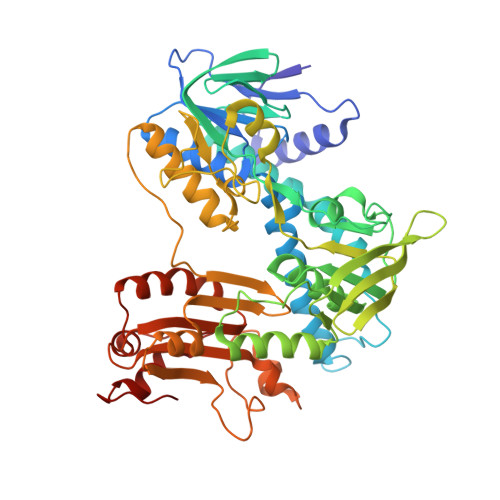The unique Phe-His dyad of 2-ketopropyl coenzyme M oxidoreductase/carboxylase selectively promotes carboxylation and S-C bond cleavage.
Prussia, G.A., Shisler, K.A., Zadvornyy, O.A., Streit, B.R., DuBois, J.L., Peters, J.W.(2021) J Biological Chem 297: 100961-100961
- PubMed: 34265301
- DOI: https://doi.org/10.1016/j.jbc.2021.100961
- Primary Citation of Related Structures:
7MGN, 7MGO - PubMed Abstract:
The 2-ketopropyl-coenzyme M oxidoreductase/carboxylase (2-KPCC) enzyme is the only member of the disulfide oxidoreductase (DSOR) family of enzymes, which are important for reductively cleaving S-S bonds, to have carboxylation activity. 2-KPCC catalyzes the conversion of 2-ketopropyl-coenzyme M to acetoacetate, which is used as a carbon source, in a controlled reaction to exclude protons. A conserved His-Glu motif present in DSORs is key in the protonation step; however, in 2-KPCC, the dyad is substituted by Phe-His. Here, we propose that this difference is important for coupling carboxylation with C-S bond cleavage. We substituted the Phe-His dyad in 2-KPCC to be more DSOR like, replacing the phenylalanine with histidine (F501H) and the histidine with glutamate (H506E), and solved crystal structures of F501H and the double variant F501H_H506E. We found that F501 protects the enolacetone intermediate from protons and that the F501H variant strongly promotes protonation. We also provided evidence for the involvement of the H506 residue in stabilizing the developing charge during the formation of acetoacetate, which acts as a product inhibitor in the WT but not the H506E variant enzymes. Finally, we determined that the F501H substitution promotes a DSOR-like charge transfer interaction with flavin adenine dinucleotide, eliminating the need for cysteine as an internal base. Taken together, these results indicate that the 2-KPCC dyad is responsible for selectively promoting carboxylation and inhibiting protonation in the formation of acetoacetate.
- Institute of Biological Chemistry, Washington State University, Pullman, Washington, USA.
Organizational Affiliation:



















